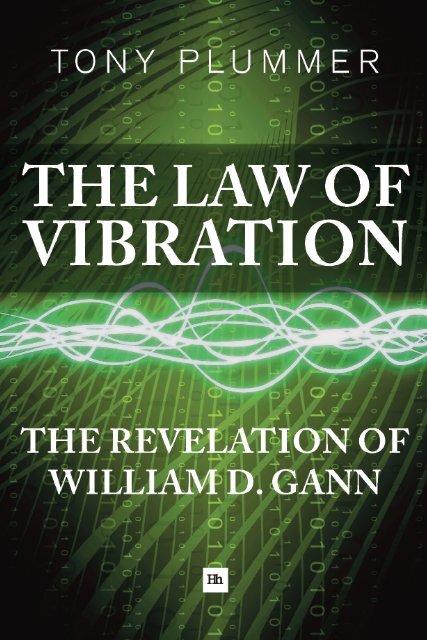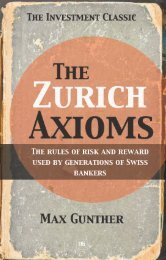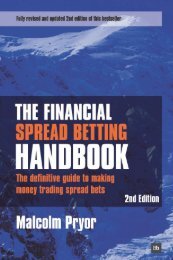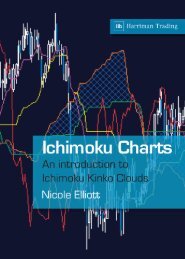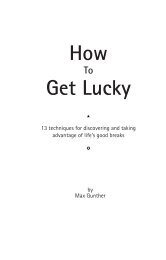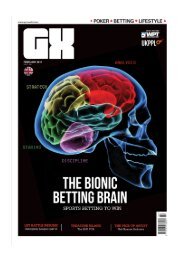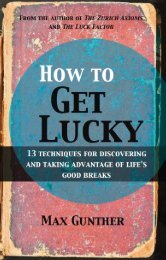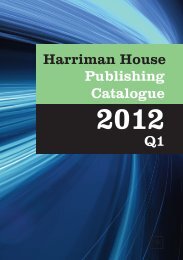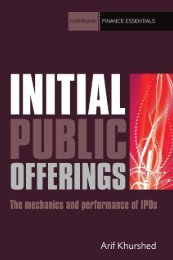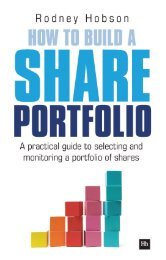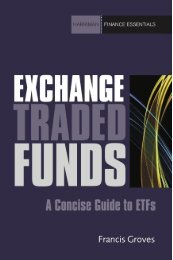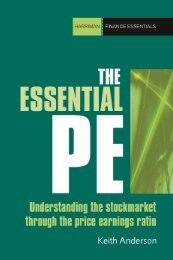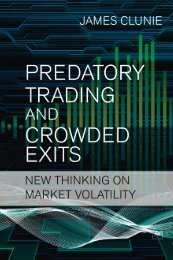Read a PDF Sample of The Law of Vibration - Harriman House
Read a PDF Sample of The Law of Vibration - Harriman House
Read a PDF Sample of The Law of Vibration - Harriman House
Create successful ePaper yourself
Turn your PDF publications into a flip-book with our unique Google optimized e-Paper software.
X X X | X X X<br />
1
• • • • <strong>Sample</strong> • • • •
<strong>The</strong> <strong>Law</strong> <strong>of</strong> <strong>Vibration</strong><br />
<strong>The</strong> Revelation <strong>of</strong><br />
William D. Gann<br />
Tony Plummer
HARRIMAN HOUSE LTD<br />
3A Penns Road<br />
Petersfield<br />
Hampshire<br />
GU32 2EW<br />
GREAT BRITAIN<br />
Tel: +44 (0)1730 233870<br />
Email: enquiries@harriman-house.com<br />
Website: www.harriman-house.com<br />
First edition published in Great Britain in 2013<br />
Copyright © Tony Plummer<br />
<strong>The</strong> right <strong>of</strong> Tony Plummer to be identified as the author has been asserted in accordance with the<br />
Copyright, Design and Patents Act 1988.<br />
978-0-85719-259-2<br />
British Library Cataloguing in Publication Data<br />
A CIP catalogue record for this book can be obtained from the British Library.<br />
All rights reserved; no part <strong>of</strong> this publication may be reproduced, stored in a retrieval system, or<br />
transmitted in any form or by any means, electronic, mechanical, photocopying, recording, or<br />
otherwise without the prior written permission <strong>of</strong> the Publisher. This book may not be lent, resold,<br />
hired out or otherwise disposed <strong>of</strong> by way <strong>of</strong> trade in any form <strong>of</strong> binding or cover other than that<br />
in which it is published without the prior written consent <strong>of</strong> the Publisher.<br />
Printed in the UK by Lightning Source.<br />
No responsibility for loss occasioned to any person or corporate body acting or refraining to act as<br />
a result <strong>of</strong> reading material in this book can be accepted by the Publisher, by the Author, or by the<br />
employer <strong>of</strong> the Author.<br />
Hh<br />
<strong>Harriman</strong> <strong>House</strong>
For the global community <strong>of</strong><br />
independently-minded technical<br />
analysts and economists
Contents<br />
About the author<br />
vii<br />
Acknowledgements<br />
vii<br />
Preface<br />
ix<br />
Introduction<br />
xi<br />
Chapter 1: <strong>The</strong> Enigma <strong>of</strong> William D. Gann 1<br />
Chapter 2: <strong>The</strong> Golden Ratio and the Christian Scriptures 11<br />
Chapter 3: <strong>The</strong> <strong>Law</strong> <strong>of</strong> Three 19<br />
Chapter 4: <strong>The</strong> Sign <strong>of</strong> the Prophet Jonas 25<br />
Chapter 5: <strong>The</strong> Son <strong>of</strong> Man in the Heart <strong>of</strong> the Earth 41<br />
Chapter 6: <strong>The</strong> Structure <strong>of</strong> the Musical Octave 53<br />
Chapter 7: <strong>The</strong> <strong>Law</strong> <strong>of</strong> Seven 59<br />
Chapter 8: <strong>The</strong> Octave and the Enneagram 67<br />
Chapter 9: <strong>The</strong> Enneagram and Financial Markets 81<br />
Chapter 10: William D. Gann and the <strong>Law</strong> <strong>of</strong> <strong>Vibration</strong> 93<br />
Chapter 11: George I. Gurdjieff and the <strong>Law</strong> <strong>of</strong> <strong>Vibration</strong> 103<br />
Chapter 12: St. Matthew’s Gospel and the <strong>Law</strong> <strong>of</strong> <strong>Vibration</strong> 115<br />
Chapter 13: A Universal Pattern <strong>of</strong> <strong>Vibration</strong> 127<br />
Chapter 14: Inner Octave Cycles 147<br />
Chapter 15: <strong>The</strong> <strong>Law</strong> <strong>of</strong> <strong>Vibration</strong> in Practice 159<br />
Chapter 16: <strong>The</strong> Final Word 175<br />
Appendices<br />
Appendix 1: Numerical Equivalents <strong>of</strong> New Testament Greek Letters 179<br />
v
T O N Y P L U M M E R<br />
T H E L A W O F V I B R A T I O N<br />
Appendix 2: St. Matthew’s Gospel, Chapter 12, Verses 38-40, Greek Text 181<br />
Appendix 3: <strong>The</strong> Vesica Piscis and Time 183<br />
Appendix 4: <strong>The</strong> Structure <strong>of</strong> William Gann’s Tunnel Thru the Air 185<br />
Appendix 5: <strong>The</strong> Structure <strong>of</strong> George Gurdjieff’s Beelzebub’s Tales 187<br />
Appendix 6: <strong>The</strong> Structure <strong>of</strong> the First 28 Chapters <strong>of</strong> Beelzebub’s Tales 189<br />
Appendix 7: <strong>The</strong> 1940-45/46 Inter-Cycle Hiatus 193<br />
Appendix 8: A Note on William Gann’s <strong>The</strong> Magic Word 195<br />
Bibliography 199<br />
Index 203<br />
v i
About the author<br />
Tony Plummer is the director <strong>of</strong> Helmsman Economics Ltd. He is a former<br />
director <strong>of</strong> Hambros Bank Ltd, <strong>of</strong> Hambros Fund Management PLC, and <strong>of</strong><br />
Rhombus Research Ltd. He is a Fellow <strong>of</strong> the Society <strong>of</strong> Technical Analysts in<br />
the UK and was, until November 2011, a Visiting Pr<strong>of</strong>essorial Fellow in the<br />
Department <strong>of</strong> Economics at Queen Mary, University <strong>of</strong> London. He is the<br />
author <strong>of</strong> Forecasting Financial Markets, which describes the influence <strong>of</strong> crowd<br />
psychology on economic activity and financial market price behaviour.<br />
Tony has worked and traded in financial markets since 1976, concentrating<br />
primarily on bonds and currencies. He now specialises in long-term economic<br />
and financial market analysis, and writes and lectures on group behaviour and<br />
trading competencies.<br />
He has a Masters degree in economics from the London School <strong>of</strong> Economics and<br />
an Honours degree in economics from the University <strong>of</strong> Kent. He has had four years<br />
<strong>of</strong> training in Core Process Psychotherapy and is a qualified NLP practitioner.<br />
Acknowledgements<br />
My thanks go very specifically to: first, my wife Glenys who has made so much<br />
possible; second, my former Executive Director and mentor at Hambros Bank<br />
Ltd, David Tapper, without whom my deep interest in financial markets would<br />
never have been catalysed; and, third, my clients at Helmsman Economics Ltd,<br />
whose desire to stay one step ahead <strong>of</strong> the consensus has persistently energised<br />
my research into the patterns <strong>of</strong> collective human behaviour.<br />
v i i
Preface<br />
I have for many years been fascinated by the hidden aspects <strong>of</strong> Nature: by the<br />
order underlying the apparent chaos; by the limited set <strong>of</strong> mathematical ratios<br />
that appear to reflect that order; and by our personal involvement in that order.<br />
It is my strong belief that individual decisions are almost always contaminated<br />
by collective beliefs and shared moods, and that therefore we have far less control<br />
over our affairs than is supposed. <strong>The</strong> result, however, is a form <strong>of</strong> systemic<br />
coherence that is not yet accepted by conventional economic theory.<br />
This book is about a critical aspect <strong>of</strong> this systemic coherence. It is about a very<br />
distinctive pattern that emerges in the presence <strong>of</strong> natural cyclical behaviour.<br />
Astonishingly, the pattern was hidden almost 2000 years ago in a small piece <strong>of</strong><br />
text in the Greek version <strong>of</strong> the Christian Gospel <strong>of</strong> St. Matthew. <strong>The</strong> pattern<br />
was unearthed, and then buried again, by the famous financial market speculator<br />
William D. Gann. And the same pattern was alluded to, but also hidden, by<br />
the great mindfulness exponent George I. Gurdjieff. <strong>The</strong> lineage <strong>of</strong> the cycle<br />
pattern suggests that it represents a genuine revelation. It has taken me more<br />
than 20 years to unravel the code that has hidden this revelation, and I feel very<br />
privileged to have been able to do it.<br />
This book, then, is about a law <strong>of</strong> vibration that is alleged to permeate the<br />
cosmos. <strong>The</strong>re is strong evidence that this law influences financial market<br />
fluctuations and economic cycles. But the exciting possibility is that signs <strong>of</strong> the<br />
law <strong>of</strong> vibration can be found in a whole range <strong>of</strong> research disciplines – from<br />
cosmology at one end to quantum physics at the other. It may be that William<br />
Gann was an important link in a chain <strong>of</strong> transmission that – at a minimum –<br />
can be dated back almost two millennia.<br />
i x
Introduction<br />
THE ROLE OF SHOCKS<br />
It is a great truth that real change only ever comes out <strong>of</strong> crisis. This is the way<br />
<strong>of</strong> evolution, which impacts all living organisms, at all levels <strong>of</strong> being and<br />
understanding. A new item <strong>of</strong> information – a shock – sends fluctuations deep<br />
into a system and the subsequent feedback becomes increasingly destabilising<br />
until the system flips into a different state. Unfortunately, the crisis is inevitably<br />
painful for all concerned. This is the path <strong>of</strong> change that involves such diverse<br />
events as wars, revolutions, stock market crashes, mental breakdowns and<br />
physical diseases.<br />
In my opinion, the 2008 financial panic and subsequent recession was just such<br />
a shock. It will undoubtedly lead to changes – both to the economy and in our<br />
understandings about how it operates – for some years to come. We could just<br />
let it all happen, and come out at the other end much older and a little wiser,<br />
but a more productive approach would be to try to understand the real causes <strong>of</strong><br />
the problem and then adjust ourselves as quickly as possible. In that way, we<br />
might be slightly less vulnerable to what Shakespeare called “outrageous fortune”. 1<br />
THE CHALLENGE TO ECONOMIC THEORY<br />
As a start, it is worth considering why economic theory was not able to anticipate<br />
the events <strong>of</strong> the last few years – that is, the explosion and collapse in various<br />
asset prices, and the associated economic boom and bust. A large part <strong>of</strong> the<br />
answer can be found in three areas <strong>of</strong> debate:<br />
1. <strong>The</strong> supposedly simplifying assumptions that are used in theoretical<br />
analysis;<br />
2. <strong>The</strong> re-balancing mechanisms that are thought to operate in an economy;<br />
and<br />
3. <strong>The</strong> effectiveness or otherwise <strong>of</strong> government in influencing those<br />
mechanisms.<br />
1<br />
William Shakespeare, Hamlet, Act 3, Scene 1.<br />
x i
T O N Y P L U M M E R<br />
T H E L A W O F V I B R A T I O N<br />
When we make decisions, we have to take account <strong>of</strong> the fact that the future<br />
may not turn out as we expect. <strong>The</strong> starting point for economics, therefore, is<br />
to consider exactly how uncertain that future is. <strong>The</strong> so-called Keynesian (i.e.<br />
fiscalist, and usually socialist) view is that the future is so uncertain – and people<br />
so naturally cautious – that the economy will not spontaneously gravitate<br />
towards full employment equilibrium. 2 In addition, it is believed that the<br />
economy is likely to over-respond to negative exogenous shocks.<br />
<strong>The</strong> neo-classical (i.e. monetarist, and usually conservative) view is that risk can<br />
be quantified in terms <strong>of</strong> probabilities and therefore priced by the relevant<br />
market. 3 Providing that markets are efficient, information is perfect and<br />
participants adhere to rational expectations, the economy will therefore be<br />
drawn towards its natural rate <strong>of</strong> unemployment. Quite obviously, a believer in<br />
Keynesian subjective uncertainty will conclude that government intervention is<br />
essential, while a believer in neo-classical objective risk will want government<br />
intrusion to be minimal.<br />
SIMPLIFYING ASSUMPTIONS<br />
So who’s right? Unfortunately, as the situation stands, the answer is neither. And<br />
it is not just a question <strong>of</strong> whether the cynical Keynesian assumption about<br />
people’s ability to deal with the future is more sensible than the unrealistic and<br />
unattainable neo-classical one. <strong>The</strong> fundamental flaw in both arguments is the<br />
presumption that people normally make their decisions independently <strong>of</strong> one<br />
another. <strong>The</strong>y do not. Neuroscience confirms that we are Janus-faced: we are<br />
self-assertive, but we also integrate into larger wholes. 4<br />
First, we depend on the observed behaviour <strong>of</strong> others to provide information<br />
that we cannot access directly ourselves. 5 This modulates, and then <strong>of</strong>fsets, the<br />
subjective uncertainty <strong>of</strong> Keynesian economics. Second, we absorb, and are<br />
stimulated by, the beliefs and emotions generated by others. This neutralises,<br />
and then destabilises, the objective risk presumed by neo-classical economists.<br />
Dependence on others’ behaviour still allows rational individual decisions, but<br />
2<br />
Robert Skidelsky, ‘<strong>The</strong> Relevance <strong>of</strong> Keynes’, Cambridge Journal <strong>of</strong> Economics (January 2011) and John M. Keynes,<br />
‘<strong>The</strong> General <strong>The</strong>ory <strong>of</strong> Employment’, Quarterly Journal <strong>of</strong> Economics (February 1937).<br />
3<br />
John F. Muth, ‘Rational Expectations and the <strong>The</strong>ory <strong>of</strong> Price Movements’, Econometrica (July 1961) and Robert<br />
Lucas, Models <strong>of</strong> Business Cycles (Basil Blackwell, Oxford, 1987).<br />
4<br />
See, for example, Alexander Easton (Ed.) and Nathan Emery (Ed.), <strong>The</strong> Cognitive Neuroscience <strong>of</strong> Social Behaviour<br />
(Psychology Press, London, 2005).<br />
5<br />
<strong>The</strong> idea <strong>of</strong> information cascading through a crowd, as a result <strong>of</strong> individuals responding to local perturbations in<br />
conditions, has become well established in Behavioural Finance. <strong>The</strong> missing element, however, is a clear recognition<br />
(and acceptance) that human beings are programmed – like animals in herds – to take note <strong>of</strong> the behaviour <strong>of</strong> others.<br />
No individual has all the information necessary for his/her survival. Research by John Dyer has found that it takes<br />
only 5% <strong>of</strong> people to have a decisive influence on the direction that a crowd <strong>of</strong> people would take; the rest simply<br />
follow. See John Dyer, et al, ‘Consensus decision making in human crowds’, Animal Behaviour 75:2 (February 2008).<br />
x i i
I N T R O D U C T I O N<br />
the absorption <strong>of</strong> others’ beliefs and moods means that these decisions are<br />
nevertheless formed within a non-rational environment.<br />
It follows from this that government spending can be a powerful influence on<br />
individual decisions and on collective beliefs. However, this is not the same as<br />
saying that government is truly an independent agency – let alone a gifted one.<br />
<strong>The</strong> weakness in interventionist policies is that policy-makers themselves are<br />
affected by the general mood. This has been all too apparent in recent years<br />
where politicians have tried to buy votes by increasing spending during boom<br />
conditions because it can be afforded, only to find themselves having to raise taxes<br />
during difficult times to share the burden. <strong>The</strong> point is that, unless government<br />
intervention is genuinely contra-cyclical, the feedback between government<br />
activity and collective psychology can be pr<strong>of</strong>oundly de-stabilising. Government<br />
activity is a source <strong>of</strong> potential risk within the economic system.<br />
ENERGY GAPS AND REBALANCING MECHANISMS<br />
<strong>The</strong> 2008 financial implosion and the associated economic recession arose from<br />
the correlated decisions <strong>of</strong> people whose mood was influenced by rapidly-rising<br />
government spending and lax credit policies. It was a reaction to excesses and<br />
was not caused by a random, externally-generated, shock. <strong>The</strong> downswing was,<br />
in fact, an energy gap within the economic system and, as such, it reversed that<br />
system’s polarity from growth to contraction.<br />
I have dealt with this phenomenon in detail elsewhere, 6 but the purpose <strong>of</strong> such<br />
a gap is to initiate a process that will cleanse the system <strong>of</strong> excesses. Once the<br />
process starts, it will continue until it is naturally complete. Of course, since<br />
economic theory does not properly recognise the influence <strong>of</strong> collective<br />
behaviour, nor recognise the adjustment mechanisms created by system excesses,<br />
it cannot define the originating causes or suggest the appropriate solutions (if,<br />
indeed, there are any). And, since economic policy decisions are dependent on<br />
economic theory, the political result is disbelief, confusion and helplessness.<br />
This sorry state <strong>of</strong> affairs exists despite the vast sums <strong>of</strong> private and public money<br />
that are devoted to research and teaching in the field <strong>of</strong> economics. New ideas<br />
obviously need to be recognised and adopted so that our understanding <strong>of</strong> reality<br />
can evolve. In my opinion, one essential change will be to include the concept <strong>of</strong><br />
collective behaviour, not just as an occasional blemish on the otherwise smooth<br />
functioning <strong>of</strong> a rational system, but as a constant influence. And, fortunately,<br />
there are signs that the process <strong>of</strong> reconsideration and revision has started. 7<br />
6<br />
Tony Plummer, Forecasting Financial Markets (6th Ed.) (Kogan Page, London, 2010).<br />
7<br />
See, for example, George A. Akerl<strong>of</strong> and Robert J. Shiller, Animal Spirits: How Human Psychology Drives the<br />
Economy, and Why it Matters for Global Capitalism (Princeton University Press, 2009).<br />
x i i i
T O N Y P L U M M E R<br />
T H E L A W O F V I B R A T I O N<br />
AN ALTERNATIVE VIEW<br />
Nevertheless, it is not certain that making alterations – however necessary – to<br />
the general equilibrium models <strong>of</strong> economic theory will actually make it any<br />
easier to deal with oscillations in economic activity. <strong>The</strong> primary reason is that<br />
such changes are unlikely to address the automatic presumption that economic<br />
and financial oscillations are the result either <strong>of</strong> people making poor decisions<br />
or <strong>of</strong> unforeseen shocks. So, almost by definition, it is assumed that the resulting<br />
perturbations are errors in the system, which can only be identified and dealt<br />
with after they have materialised.<br />
But what if such assumptions were incorrect? What if fluctuations in economic<br />
activity and financial market prices were essentially a non-random consequence<br />
<strong>of</strong> collective behaviour? And what if a significant part <strong>of</strong> such fluctuations could,<br />
in fact, be anticipated?<br />
<strong>The</strong> purpose <strong>of</strong> this book is to demonstrate that this alternative view was<br />
fundamental to the success <strong>of</strong> one <strong>of</strong> the greatest stock market traders <strong>of</strong> all time<br />
– William D. Gann. He believed – and traded upon – the idea that collective<br />
human behaviour exhibits a specific recurring pattern that unfolds through time.<br />
If Mr. Gann’s financial success is a yardstick for genuine wisdom, then economic<br />
theory still has a significant paradigm shift to negotiate.<br />
<strong>The</strong>re are three aspects to the idea <strong>of</strong> non-random collective behaviour that need<br />
to be registered straightaway. First, it implies that there are forces at work about<br />
which we have very little conception and over which we (therefore) have very<br />
little control. Second, it implies that collective behaviour is not only nonrandom<br />
but is the outer signature <strong>of</strong> an inner system process that actively<br />
organises the behaviour <strong>of</strong> participating individuals. 8 And third, it implies that<br />
when individuals lose themselves to group behaviour – i.e. let their psychic<br />
structure be invaded and overrun by group demands 9 – their energies are in a<br />
sense sacrificed to group purposes. This deeply disturbing notion helps to<br />
explain the madness <strong>of</strong> financial market crowds, the blindness <strong>of</strong> religious and<br />
nationalist fervour, and the destructive power <strong>of</strong> a rioting mob.<br />
<strong>The</strong> main point is that the phenomenon <strong>of</strong> collective behaviour involves two<br />
specific forces: directing people’s energies towards objectives other than their<br />
own; and placing limitations on people’s willingness to use their energies for<br />
alternative, non-group, purposes. <strong>The</strong> result, in effect, is an organism with its<br />
own simplistic psychological process. Moreover, this organism is characterised<br />
by energy fluctuations that are both rhythmic and patterned.<br />
8<br />
Tony Plummer, Forecasting Financial Markets.<br />
9<br />
Erich Neumann, Depth Psychology and a New Ethic (Shambhala, Boston (Ma.), 1990).<br />
x i v
I N T R O D U C T I O N<br />
OLD AND ANCIENT TEXTS<br />
Mr. Gann was quite explicit in claiming that the foundation <strong>of</strong> his knowledge<br />
was a small piece <strong>of</strong> text in one <strong>of</strong> the Christian Gospels. 10 <strong>The</strong> text had been<br />
written by St. Matthew (or by individuals who wrote under that name) and gave<br />
great significance to “the sign <strong>of</strong> the prophet Jonas”. It seems that Mr. Gann<br />
had deduced that the sign was a reference to a universal law relating to cycles.<br />
My early inference was that, if Mr Gann’s claims were in any sense correct, then<br />
some form <strong>of</strong> gematria was likely to be involved. Gematria is the technique <strong>of</strong><br />
allocating numbers to letters in a text in order to convey extra information, and<br />
it was widely used by writers <strong>of</strong> ancient scripture to transmit esoteric<br />
understandings. This, in turn, suggested that the appropriate text to be used in<br />
St. Matthew’s case was the original Greek version.<br />
This turned out to be the case and, by the mid-1990s, I had found some<br />
extraordinary geometric figures hidden within St. Matthew’s text. However, Mr.<br />
Gann’s central claim – that “the sign <strong>of</strong> the prophet Jonas” specifically provided<br />
a revelation about cycles – continued to elude me. <strong>The</strong>n, in late 2011, I chanced<br />
upon a research thesis by Sophia Wellbeloved referencing the struggle by the<br />
celebrated mindfulness exponent George I. Gurdjieff to produce a series <strong>of</strong><br />
books that would preserve his teachings. 11 It alerted me to the possibility that St.<br />
Matthew’s text may have incorporated a transmission methodology that<br />
extended beyond gematria. And this, amazingly, also turned out to be the case.<br />
<strong>The</strong> results are literally extra-ordinary. <strong>The</strong>y will be analysed in some detail in<br />
the following chapters in terms <strong>of</strong> the common themes and transmission<br />
techniques incorporated into three texts: W.D. Gann’s <strong>The</strong> Tunnel Thru <strong>The</strong> Air<br />
(hereafter Tunnel), 12 G.I. Gurdjieff’s Beelzebub’s Tales to His Grandson (hereafter<br />
Beelzebub’s Tales), 13 and St. Matthew’s Gospel. 14<br />
William Delbert Gann died in 1955. He left behind a thought-provoking<br />
combination <strong>of</strong> very little money in his estate and a reputation <strong>of</strong> being one <strong>of</strong><br />
the greatest stock market traders <strong>of</strong> all time. George Ivanovitch Gurdjieff died<br />
in 1949. He left behind a reputation for being exploitative and difficult to be<br />
with, but also a unique set <strong>of</strong> complex and deeply spiritual teachings that have<br />
the power to change people’s lives for the better. St. Matthew probably died in<br />
the first century AD. Very little is known about him, but he left behind a record<br />
<strong>of</strong> the teachings <strong>of</strong> a man called Joshua ben Joseph, who is now referred to as<br />
Jesus. Those teachings had a pr<strong>of</strong>ound effect on the course <strong>of</strong> history.<br />
10<br />
William D. Gann, <strong>The</strong> Tunnel Thru <strong>The</strong> Air (Financial Guardian Publishing, New York, 1927).<br />
11<br />
Sophia Wellbeloved, Gurdjieff, Astrology & Beelzebub’s Tales (Abintra Books, Aurora (Or.), 2002).<br />
12<br />
Gann, Tunnel.<br />
13<br />
George I. Gurdjieff, All and Everything: An Objectively Impartial Criticism <strong>of</strong> the Life <strong>of</strong> Man, or Beelzebub’s Tales to<br />
His Grandson (Routledge & Kegan Paul, London, 1950).<br />
14<br />
Kurt Aland et al., Greek-English New Testament (Deutsche Bibelgesellschaft, Stuttgart, 1981).<br />
x v
T O N Y P L U M M E R<br />
T H E L A W O F V I B R A T I O N<br />
<strong>The</strong> thread that links each <strong>of</strong> these writers in the context <strong>of</strong> this book is that they<br />
included secret/sacred geometries within the structure <strong>of</strong> their original written<br />
works. 15 <strong>The</strong>se hidden geometries point to a fundamental pattern <strong>of</strong> vibration<br />
that is alleged to pervade the cosmos and that interacts with humanity on a<br />
personal and collective level. Mr. Gann called this pattern the “law <strong>of</strong> vibration”.<br />
<strong>The</strong> pattern is said to emerge as a result <strong>of</strong> discontinuities in the perpetual<br />
processes <strong>of</strong> expansion and contraction within the cosmos. According to Mr.<br />
Gurdjieff, the discontinuities are a function <strong>of</strong> the <strong>Law</strong> <strong>of</strong> Seven, and the forces<br />
<strong>of</strong> expansion and contraction are a function <strong>of</strong> the <strong>Law</strong> <strong>of</strong> Three. Amazingly,<br />
and compellingly, the writings <strong>of</strong> St. Matthew confirm that the pattern was<br />
known about almost 2000 years ago.<br />
15<br />
It cannot be emphasised enough that, once the original texts have been revised and/or translated, the hidden<br />
information becomes inaccessible.<br />
x v i
CHAPTER 1<br />
THE ENIGMA OF<br />
WILLIAM D. GANN<br />
“‘<strong>The</strong> Tunnel Thru <strong>The</strong> Air’ is mysterious and contains a valuable secret,<br />
clothed in a veiled language.”<br />
W. D. Gann<br />
A SECRET TRADING METHODOLOGY<br />
William D. Gann was – by reputation – one <strong>of</strong> the most successful commodity<br />
and stock traders who ever lived. He operated in the United States during the<br />
early part <strong>of</strong> the twentieth century, was able to forecast the 1929 Wall Street<br />
Crash, 1 and is reputed to have amassed tens <strong>of</strong> millions <strong>of</strong> dollars through shortterm<br />
speculation. 2 He is also reputed to have had access to a unique trading<br />
methodology whose central feature was a secret. He died in 1955, leaving behind<br />
a great deal <strong>of</strong> confusion as to whether or not he had actually revealed this secret.<br />
It is known – partly through Mr. Gann’s own admission – that the secret<br />
belonged to a hidden order <strong>of</strong> understanding. 3 This fact, more than anything<br />
else, has hampered open-minded research into his techniques: either his work<br />
has been associated with an irreligious view <strong>of</strong> the world or it has been regarded<br />
as being non-scientific hocus-pocus.<br />
1<br />
William D. Gann, Supply and Demand Letter: 1929 Annual Stock Forecast (W. D. Gann Scientific Service Inc, New<br />
York, 23 November 1928).<br />
2<br />
This was at a time when the average annual wage <strong>of</strong> a non-farm worker was about $1,500. See Stanley Lebergott,<br />
‘Wages and Working Conditions’, <strong>The</strong> Concise Encyclopedia <strong>of</strong> Economics (Library <strong>of</strong> Economics and Liberty,<br />
Indianapolis (In.), 1993).<br />
3<br />
Gann, Tunnel.<br />
1
T O N Y P L U M M E R<br />
T H E L A W O F V I B R A T I O N<br />
More recently, however, with the questioning <strong>of</strong> conventional religious beliefs,<br />
and with the growing realisation that the accuracy <strong>of</strong> scientific research is<br />
dependent on the contextual assumptions that are being used, an increasing<br />
number <strong>of</strong> people have been prepared to look more closely at Mr. Gann’s ideas.<br />
This has probably been particularly easy for financial market traders ins<strong>of</strong>ar as<br />
the primary test for truth is pr<strong>of</strong>itability rather than religious or scientific nicety.<br />
To date, the most important line <strong>of</strong> research has been in the area <strong>of</strong> astrology.<br />
Mr. Gann is known to have been particularly interested in the relationship<br />
between planetary alignments and human psychology, 4 and researchers have –<br />
with some justification – followed his lead. <strong>The</strong> findings need to be taken<br />
seriously because they confirm that correlations do exist between price<br />
movements and the positions <strong>of</strong> the planets. 5 More broadly, there is a growing<br />
body <strong>of</strong> evidence that correlations exist between mass human psychology and<br />
extra-terrestrial cycles. 6<br />
Nevertheless, astrology was not the only element <strong>of</strong> Mr. Gann’s trading rules. A<br />
given astrological aspect might constitute a potential turning point, but there is<br />
always a degree <strong>of</strong> uncertainty as to whether a price reversal will actually occur;<br />
and uncertainty does not appear to be one <strong>of</strong> Mr. Gann’s characteristics. He<br />
undoubtedly had access to other techniques that supplemented (or even<br />
supplanted) his astrological findings.<br />
THE LAW OF VIBRATION<br />
As anyone who has had contact with his work will know, the dominant (and<br />
unusual) feature <strong>of</strong> Mr. Gann’s ideas was the use <strong>of</strong> mathematics and geometry.<br />
What is not clear from the available literature, however, is the actual source <strong>of</strong><br />
(or originating authority for) these particular analytical tools. In his early years<br />
<strong>of</strong> trading, Mr. Gann was quite clear in stating that he had access to special<br />
knowledge. In 1909, he had indicated that he knew a secret law <strong>of</strong> vibration. 7<br />
In 1927, he further emphasised the point that there was a “hidden secret” that<br />
others could learn. 8<br />
Moreover, there was a degree <strong>of</strong> commitment to his research on the law <strong>of</strong><br />
vibration that suggests that it wasn’t just a loosely conceptualised idea. In 1909,<br />
Mr. Gann maintained that he had spent ten years doing exhaustive research,<br />
including “nine months, working night and day in the Astor Library <strong>of</strong> New<br />
4<br />
Ibid.<br />
5<br />
In this context, mention needs to be made <strong>of</strong> the exceptional work done by Bradley F. Cowan. See, for example,<br />
his Pentagonal Time Cycle <strong>The</strong>ory (Private publication, USA, 2009).<br />
6<br />
See especially Richard Tarnas, Cosmos and Psyche: Intimations <strong>of</strong> a New World View (Plume, New York, 2007).<br />
7<br />
Interview with William D. Gann, <strong>The</strong> Ticker and Investment Digest 5:2 (December 1909).<br />
8<br />
Gann, Tunnel.<br />
2
T H E E N I G M A O F W I L L I A M D . G A N N<br />
C H A P T E R 1<br />
York and in the British Museum <strong>of</strong> London”. 9 Since Mr. Gann was born in 1878,<br />
this means that he started his research no later than the age <strong>of</strong> 21. Furthermore,<br />
a journey to London in the early 1900s would have been both time consuming<br />
and expensive.<br />
Given his persistent reference to his knowledge as being secret, it seems probable<br />
that Mr. Gann had access to an understanding about the nature <strong>of</strong> life that was<br />
different to the understandings held by the contemporaneous religious and<br />
scientific communities. 10 If this is correct, it does not take a significant leap <strong>of</strong><br />
imagination to suppose that the knowledge was genuinely esoteric and that Mr.<br />
Gann was using the ancient science <strong>of</strong> sacred geometry. This is certainly<br />
consistent with the reverential attitude to spiritual matters that he openly<br />
expressed in his 1950 book, <strong>The</strong> Magic Word. 11 Even so, there is an important<br />
point about this that is almost always missed. This is that sacred geometry<br />
cannot be applied to a mundane data series without a prior knowledge <strong>of</strong> the<br />
energetic forces that are driving that series. <strong>The</strong> analyst has to know what he or<br />
she is looking for. In other words, there is still something missing from extant<br />
knowledge about Mr. Gann’s techniques.<br />
It is, therefore, very relevant that two elements are missing from what we know<br />
about Mr. Gann’s knowledge. First, no one has yet revealed, or been able to<br />
explain with any precision, how Mr. Gann’s law <strong>of</strong> vibration is supposed to<br />
operate in financial markets. Second, as far as I know, nowhere does Mr. Gann<br />
explicitly mention the Golden Measure 12 or its related number series, the<br />
Fibonacci Sequence. 13 <strong>The</strong>se omissions seem to me to be more significant than<br />
Mr. Gann’s commission <strong>of</strong> geometry (and astrology). As this book will argue,<br />
not only do the law <strong>of</strong> vibration and the Golden Measure co-arise in all natural<br />
phenomena, but both were important parts <strong>of</strong> Mr. Gann’s understandings about<br />
financial market behaviour. Indeed, he preserved them in a hidden form in his<br />
strange 1927 novel, Tunnel. 14<br />
THE TUNNEL THRU THE AIR<br />
As anyone who has tried to read Tunnel will attest, it is hardly a work <strong>of</strong> literary<br />
genius in the conventional sense <strong>of</strong> the word. Indeed, the word dreadful would<br />
9<br />
<strong>The</strong> Ticker and Investment Digest (December 1909).<br />
10<br />
Gann, Tunnel. In the story, Robert Gordon – Mr. Gann’s alter ego – says that “<strong>The</strong> general public is not yet ready<br />
for it (i.e. the secret) and probably would not understand or believe it if I explained it.”<br />
11<br />
William D. Gann, <strong>The</strong> Magic Word (Library <strong>of</strong> Gann Publishing Co, Pomeroy (Wa.), 1950).<br />
12<br />
<strong>The</strong> late Robert Krausz mentioned this in a lecture that he gave at a Computrac conference in 1992. <strong>The</strong> Golden<br />
Measure is a number (0.618), a ratio (0.618:1) and a continuous proportion between three numbers (0.382, 0.618,<br />
and 1). See Chapters 2 and 3.<br />
13<br />
<strong>The</strong> Fibonacci Sequence is the number series 0, 1, 1, 1, 2, 3, 5, 8, 13, 21, 34, 55,… etc. where the ratio <strong>of</strong> each<br />
number divided by its successor tends towards the Golden Ratio, 0.618:1.<br />
14<br />
Gann, Tunnel.<br />
3
T O N Y P L U M M E R<br />
T H E L A W O F V I B R A T I O N<br />
be a very charitable appellation. Mr. Gann’s injunction is to read the book three<br />
times: firstly, as an ordinary novel; secondly, to discern some <strong>of</strong> the hidden<br />
meanings; and thirdly, to find the hidden secret. 15 In other words, the reader has<br />
to look within the text for something far more important than the book’s<br />
improbable love and war story. 16<br />
Throughout most <strong>of</strong> the book, Mr Gann uses the unusual device <strong>of</strong> having the<br />
relationship between the hero, Robert Gordon, and his future wife, Marie<br />
Stanton, conducted by the continuous exchange <strong>of</strong> letters. He also includes –<br />
sometimes within letters, but <strong>of</strong>ten separately – extensive quotations from the<br />
Bible, and a number <strong>of</strong> poems. <strong>The</strong> first point is that the procedure, in effect,<br />
pads out the story. More specifically, the addition <strong>of</strong> unnecessary material to a<br />
chapter can be used as a device to control the number <strong>of</strong> pages in that chapter.<br />
As we shall see, this turns out to be very important.<br />
Second, the interchange <strong>of</strong> letters themselves may be taken as a metaphor for the<br />
oscillation between the generative and receptive polarities within Nature. This<br />
interpretation is strengthened by the regular intervention in the exchange <strong>of</strong> letters<br />
by a third party – namely, Mr. Walter Kennelworth. Technically, a third force is<br />
always necessary to balance and direct the exchange between the active (male)<br />
and passive (female) polarities. Indeed, Mr. Gann allows Robert Gordon to state<br />
that “In every law <strong>of</strong> nature there is… a positive, a negative and a neutral”. 17<br />
<strong>The</strong> three forces, taken together, constitute an ancient spiritual law, called the<br />
<strong>Law</strong> <strong>of</strong> Three.<br />
<strong>The</strong> <strong>Law</strong> <strong>of</strong> Three<br />
<strong>The</strong> traditional symbol for the <strong>Law</strong> <strong>of</strong> Three was either an equilateral or isosceles<br />
triangle 18 and the traditional mathematical representation <strong>of</strong> the law was the<br />
Golden Ratio, 0.618:1 or 0.382:0.618. It is therefore relevant that the original<br />
dust jacket <strong>of</strong> Tunnel contains at least three references to the <strong>Law</strong> <strong>of</strong> Three. <strong>The</strong><br />
first reference is a tiny equilateral triangle just inside the lower margin (which<br />
contains the infrastructure <strong>of</strong> a city). <strong>The</strong> second is an isosceles triangle on the<br />
top <strong>of</strong> a spire that projects itself out <strong>of</strong> that lower margin. <strong>The</strong> important point<br />
is that the positions <strong>of</strong> both triangles in relation to the width <strong>of</strong> the book are<br />
then defined by the Golden Ratio: the distance from the left-hand side <strong>of</strong> the<br />
book is 38.2% <strong>of</strong> the width <strong>of</strong> the book for the equilateral triangle and 61.8%<br />
15<br />
Ibid.<br />
16<br />
It is not my intention to provide a comprehensive analysis <strong>of</strong> <strong>The</strong> Tunnel Thru <strong>The</strong> Air – mainly because, for the<br />
purposes <strong>of</strong> this book, it is not necessary to do so. Nevertheless, this should not be taken to mean that all Mr. Gann’s<br />
secrets are described in what follows.<br />
17<br />
Gann, Tunnel. It is the reference to a neutral force that establishes Mr. Gann’s credibility. <strong>The</strong> existence <strong>of</strong> this<br />
force was largely unknown at the time that Mr. Gann was writing Tunnel.<br />
18<br />
An equilateral triangle has three sides <strong>of</strong> equal length. An isosceles triangle has two sides <strong>of</strong> equal length.<br />
4
T H E E N I G M A O F W I L L I A M D . G A N N<br />
C H A P T E R 1<br />
for the isosceles triangle; and the distance from the right-hand side <strong>of</strong> the book<br />
is 61.8% <strong>of</strong> the width <strong>of</strong> the book for the equilateral triangle and 38.2% for the<br />
isosceles triangle. Moreover, the measurements are exact. See Figure 1-1.<br />
<strong>The</strong> third reference to the <strong>Law</strong> <strong>of</strong> Three is easy to miss. <strong>The</strong> author’s name is<br />
centred under the title <strong>of</strong> the book, but the title itself is <strong>of</strong>fset from centre. This<br />
is also shown in Figure 1-1. <strong>The</strong> consequence is that the trailing edge <strong>of</strong> the first<br />
letter <strong>of</strong> the author’s name is located precisely over the equilateral triangle in the<br />
lower margin. Hence, the distance from the left-hand side <strong>of</strong> the book to the<br />
start <strong>of</strong> the author’s name is 38.2% <strong>of</strong> the width <strong>of</strong> the book, and the author’s<br />
name, W. D. Gann, is then contained within the remaining 61.8% <strong>of</strong> the width<br />
<strong>of</strong> the book. 19<br />
<strong>The</strong>se three oblique references to the <strong>Law</strong> <strong>of</strong> Three are unlikely to have been an<br />
accident. Indeed, once a reader starts looking at Tunnel with the prior knowledge<br />
that it contains evidence <strong>of</strong> the <strong>Law</strong> <strong>of</strong> Three, it becomes increasingly obvious<br />
that the whole book was carefully designed to resonate with it. Each page is 4-<br />
7/8 inches wide and 7-3/16 inches high. <strong>The</strong> ratio between the two<br />
measurements approximates 0.666:1 which – as we shall see – is closely linked<br />
to the Biblical presentation <strong>of</strong> the Golden Ratio.<br />
FIGURE 1-1: SCHEMATICS OF MR. GANN’S ORIGINAL BOOK JACKET AND PAGE LAYOUT<br />
19<br />
<strong>The</strong> references on the dust jacket to the Golden Ratio have, <strong>of</strong> course, been lost in subsequent redesigned editions<br />
<strong>of</strong> Tunnel.<br />
5
T O N Y P L U M M E R<br />
T H E L A W O F V I B R A T I O N<br />
Meanwhile, the text on each page is presented in an area that measures 3-5/16<br />
inches across and 5-3/8 inches down. <strong>The</strong> ratio <strong>of</strong> the width to the height is<br />
therefore 0.618:1. Each page, therefore, consists <strong>of</strong> a 0.666 x 1 biblical rectangle<br />
containing a 0.618 x 1 ‘Golden’ Rectangle. 20 Again, see Figure 1-1.<br />
<strong>The</strong> <strong>Law</strong> <strong>of</strong> Three will be analysed in more detail in Chapter 3. It is, however,<br />
only one element <strong>of</strong> the information that was hidden in Tunnel. Mr. Gann<br />
allows Robert Gordon to speak <strong>of</strong> an immutable “law <strong>of</strong> vibration”, which is<br />
mathematically precise and which repeats itself as a series <strong>of</strong> cycles within cycles.<br />
Gordon is also shown to be critically aware <strong>of</strong> the importance <strong>of</strong> the number 7.<br />
<strong>The</strong> climax <strong>of</strong> activity in Tunnel, for example, is called “Robert Gordon’s Seven<br />
Days” where Gordon puts people to sleep for seven days and, during that time,<br />
destroys those <strong>of</strong> their buildings that are associated with religion, government,<br />
and business. He starts the task at 07.00 hrs on the 21st (3 x 7) day <strong>of</strong> the 7th<br />
month (July), and returns 7 days later. 21<br />
This placement <strong>of</strong> the number 7 in the context <strong>of</strong> cyclical time references a<br />
second ancient spiritual law, called the <strong>Law</strong> <strong>of</strong> Seven.<br />
<strong>The</strong> <strong>Law</strong> <strong>of</strong> Seven<br />
<strong>The</strong> <strong>Law</strong> <strong>of</strong> Seven is the law <strong>of</strong> vibration. It defines the pattern <strong>of</strong> rhythmic time<br />
cycles and identifies the critical points in these cycles where evolutionary change<br />
can occur. At its simplest level, the <strong>Law</strong> <strong>of</strong> Seven is inherent in, and defined by,<br />
the conventional Tonic Sol-Fa musical scale. 22 In its more complex form, the<br />
<strong>Law</strong> describes the patterns <strong>of</strong> oscillation in collective human behaviour. <strong>The</strong><br />
<strong>Law</strong> <strong>of</strong> Seven will be analysed in more detail in Chapter 7.<br />
<strong>The</strong> central proposal contained in Tunnel, therefore, is that economic activity<br />
and financial market speculation are both driven by two great cosmic laws: the<br />
<strong>Law</strong> <strong>of</strong> Three and the <strong>Law</strong> <strong>of</strong> Seven. <strong>The</strong> laws have a long history but, by<br />
tradition, knowledge about them has only been transmitted orally – and then<br />
only in the context <strong>of</strong> psycho-spiritual development. So how did Mr. Gann<br />
know about their existence, possibly even as early as 1898? In Tunnel, Mr. Gann<br />
(in the guise <strong>of</strong> Robert Gordon) states that he has “gained a great deal <strong>of</strong><br />
knowledge by following the Bible”. 23 This suggests that the two laws (or<br />
something very similar) are somehow hidden within the Bible.<br />
20<br />
Artists have long known that the average person finds the Golden Rectangle attractive. See, for example, Mario<br />
Livio, <strong>The</strong> Golden Ratio (Review, London, 2002).<br />
21<br />
“Robert Gordon’s Seven Days” is the title <strong>of</strong> Chapter 39 (written XXXIX). Chapter 39 nevertheless lies between<br />
Chapters 33 and 35. This is unlikely to have been an accident, although its meaning is unclear. First, it may be an<br />
echo <strong>of</strong>, or an acknowledgement <strong>of</strong>, an earlier reference in Tunnel to Ezekiel, Chapter 39, which references a burning<br />
<strong>of</strong> the weapons <strong>of</strong> war over a period <strong>of</strong> seven years. This correlates with Robert Gordon’s destruction <strong>of</strong> various cities<br />
in seven days. Second, it may be an allusion to a relationship between verse 39 in St. Matthew’s Gospel and the <strong>Law</strong><br />
<strong>of</strong> Seven. Verse 39 is the starting point for a series <strong>of</strong> calculations that reveals the presence <strong>of</strong> the <strong>Law</strong> <strong>of</strong> Seven.<br />
22<br />
It has, therefore, also been referred to as the “<strong>Law</strong> <strong>of</strong> Octaves”.<br />
23<br />
Gann, Tunnel.<br />
6
BIBLE SECRETS<br />
T H E E N I G M A O F W I L L I A M D . G A N N<br />
C H A P T E R 1<br />
It is an important fact that the Bible – like all ancient, and genuinely sacred,<br />
scripture – has two dimensions: the exoteric dimension, which deals primarily<br />
with external laws; and an esoteric (secret/sacred) dimension, which deals with<br />
inner (spiritual) laws. <strong>The</strong> latter dimension can only be accessed under the right<br />
circumstances – not the least <strong>of</strong> which is that it is accepted as existing in the<br />
first place. It follows, therefore, that if Mr. Gann was able to unlock the Bible’s<br />
innermost secrets then he must also have had access to the necessary keys.<br />
Unfortunately, and until relatively recently, Christian authorities have tended to<br />
deny the existence <strong>of</strong> an esoteric dimension to the Bible. Consequently, many<br />
practising Christians have viewed the assertion <strong>of</strong> its existence as being in some<br />
way evil, because it was occult. This point would not have been lost on Mr. Gann,<br />
and would undoubtedly have contributed to his circumspection in revealing the<br />
details <strong>of</strong> his knowledge. We shall be dealing with one <strong>of</strong> the relevant insights in<br />
Chapters 2 and 3. In the meantime, what is the pro<strong>of</strong> that Mr. Gann had the<br />
necessary keys to access the hidden inner dimensions <strong>of</strong> the Bible?<br />
In Tunnel, Mr. Gann refers directly to “the sign <strong>of</strong> the prophet Jonas”, which is<br />
the subject <strong>of</strong> Chapter 12 <strong>of</strong> St. Matthew’s Gospel. 24 Robert Gordon is made to<br />
say that “I believe that a man who understands the meaning <strong>of</strong> that [sign] has all<br />
the power under heaven and earth… I believe that that is the key to the<br />
interpretation <strong>of</strong> the future. I am sure I have found it and know how to apply it.”<br />
<strong>The</strong> analysis <strong>of</strong> St. Matthew’s text is complicated and requires a prior knowledge<br />
<strong>of</strong> the ancient science <strong>of</strong> numbers. Nevertheless, once the correct tools are<br />
applied, the text reveals the presence <strong>of</strong> very meaningful mathematical and<br />
geometrical constructs. As Mr. Gann claimed, these do indeed include direct<br />
references to a law <strong>of</strong> vibration. We shall explore St Matthew’s text in Chapters<br />
4 and 5, and then look at some <strong>of</strong> the implications in Chapter 12. 25<br />
<strong>The</strong> anomaly in terms <strong>of</strong> Mr. Gann’s claims, however, is that “the sign <strong>of</strong> the<br />
prophet” itself does not reveal either how the laws actually work or how they<br />
should be applied. In other words, it is still necessary to know about the existence<br />
– and operation – <strong>of</strong> the <strong>Law</strong> <strong>of</strong> Three and the <strong>Law</strong> <strong>of</strong> Seven prior to interpreting<br />
St. Matthew’s text. It is thus difficult to get away from the conclusion that the<br />
Bible may not have been the only source <strong>of</strong> Mr. Gann’s insights. He almost<br />
certainly obtained the initial knowledge from somewhere else.<br />
24<br />
St. Matthew: Chapter 12, verses 38-40: “<strong>The</strong>n certain <strong>of</strong> the scribes and Pharisees answered, saying, Master, we<br />
would see a sign from thee. But he answered and said unto them: “An evil and adulterous generation seeketh after<br />
a sign; and there shall no sign be given it, but the sign <strong>of</strong> the prophet Jonas: For as Jonas was three days and nights<br />
in the whale’s belly; so shall the Son <strong>of</strong> man be three days and three nights in the heart <strong>of</strong> the earth.”<br />
25<br />
Some <strong>of</strong> its implications remain beyond the understanding <strong>of</strong> this author.<br />
7
T O N Y P L U M M E R<br />
T H E L A W O F V I B R A T I O N<br />
BEELZEBUB’S TALES<br />
It is a fact that Tunnel has some remarkable parallels with a book, written by<br />
George Ivanovitch Gurdjieff, entitled All and Everything: An Objectively<br />
Impartial Criticism <strong>of</strong> the Life <strong>of</strong> Man, or Beelzebub’s Tales to His Grandson<br />
(hereafter, Beelzebub’s Tales). 26 This book is an allegorical novel that claims to<br />
contain a body <strong>of</strong> sacred knowledge concerning the laws <strong>of</strong> the universe. <strong>The</strong><br />
book is difficult to read because its structure and language were carefully<br />
designed to avoid loose interpretation. It has, in effect, to be translated. 27 But<br />
one <strong>of</strong> the important disclosures contained in the book is the existence <strong>of</strong> the<br />
<strong>Law</strong> <strong>of</strong> Three and the <strong>Law</strong> <strong>of</strong> Seven.<br />
<strong>The</strong> differences in content between Tunnel and Beelzebub’s Tales could not –<br />
literally! – be greater. Nevertheless, there are some significant parallels between<br />
the two books. Mr. Gann and Mr. Gurdjieff both claim that their books contain<br />
secrets that can only be accessed if they are read three times. Both authors<br />
indicate that the first reading is essentially an ordinary process; both indicate<br />
that the second reading should be approached as part <strong>of</strong> a learning process; and<br />
both maintain that the secret will start to become apparent on the third reading.<br />
Of course, the fact that both authors suggest that their book be read three times<br />
may just be a coincidence, based on the desire to transmit the idea that the<br />
number 3 itself is important.<br />
What will also become apparent is that Tunnel and Beelzebub’s Tales both use<br />
the same, very specific, technique to hide the particular pattern that is intrinsic<br />
to the law <strong>of</strong> vibration/<strong>Law</strong> <strong>of</strong> Seven within their books. Once the code has been<br />
broken, both books reveal the same pattern. Furthermore – and as a most<br />
amazing confirmation – the pattern is the same as that contained within “the<br />
sign <strong>of</strong> the prophet Jonas”. 28<br />
A COMMON SOURCE<br />
Although these parallels suggest that Mr. Gann may have obtained his<br />
knowledge from Mr. Gurdjieff, such contact seems unlikely. Mr. Gann claimed<br />
that he knew about a law <strong>of</strong> vibration in 1909. At that stage, Mr. Gurdjieff (who<br />
was only about five years older than Mr. Gann) was living in Eastern Europe<br />
and had not even made a known public appearance. 29 Moreover, although Mr.<br />
26<br />
Gurdjieff, Beelzebub’s Tales.<br />
27<br />
<strong>The</strong> earliest and most complete summary <strong>of</strong> Mr. Gurdjieff’s work, written in an understandable form, is<br />
contained in Pyotr D. Ouspensky, In Search <strong>of</strong> the Miraculous: Fragments <strong>of</strong> an Unknown Teaching (Harcourt, Brace<br />
& World, New York, 1949).<br />
28<br />
<strong>The</strong>re are other parallels that are worth noting. Both books contain references to astrology – Tunnel explicitly and<br />
Beelzebub’s Tales implicitly. Both books use Roman numerals for chapter headings.<br />
29<br />
Colin Wilson, G. I. Gurdjieff: <strong>The</strong> War Against Sleep (<strong>The</strong> Aquarian Press, Wellingborough, 1986).<br />
8
T H E E N I G M A O F W I L L I A M D . G A N N<br />
C H A P T E R 1<br />
Gurdjieff started to write Beelzebub’s Tales in late 1924, it was not available to<br />
the general public until 1950. Mr. Gann published Tunnel in 1927, so he could<br />
not have read Mr. Gurdjieff’s finished book. 30<br />
This is by no means conclusive, but it does raise the possibility <strong>of</strong> the existence<br />
<strong>of</strong> another – common – originating source, which would have pre-dated both<br />
men. Mr. Gann was a highly-placed Freemason, which may have given him access<br />
to information that was not otherwise generally available 31 and Mr. Gurdjieff was<br />
always quite clear that he had obtained his knowledge from elsewhere. 32<br />
<strong>The</strong> truth is that we’ll probably never know precisely where the information<br />
came from, how Mr. Gann obtained it, or why he ended up hiding it. But there<br />
is no question that Mr. Gann and Mr. Gurdjieff were somehow on a parallel<br />
path, and that their respective insights about the functioning <strong>of</strong> a law <strong>of</strong><br />
vibration emerged almost simultaneously.<br />
More tellingly, both men chose to bury a particular aspect <strong>of</strong> their insights,<br />
either as a challenge to their students or for future use. Tunnel and Beelzebub’s<br />
Tales both use the same specific method <strong>of</strong> transmitting vital information; both<br />
hid the same particular pattern relating to natural cycles; and both accepted the<br />
existence <strong>of</strong> cosmic laws that, in the 1920s, would have been regarded with<br />
suspicion. <strong>The</strong> coincidences are far too meaningful to be totally ignored.<br />
So, what are these cosmic laws, and how are they hidden in the Bible?<br />
30<br />
<strong>The</strong>re are other points <strong>of</strong> potential contact. It is quite possible, for example, that Mr. Gann knew about Mr.<br />
Gurdjieff’s teachings, and was attracted to them because <strong>of</strong> his interest in the law <strong>of</strong> vibration. <strong>The</strong>re were lectures<br />
– given by Alfred Orage and other high calibre followers <strong>of</strong> Mr. Gurdjieff – both in New York and London in the<br />
early 1920s. Indeed, Mr Gurdjieff himself was in New York in 1924 and 1925-26. In addition, draft copies <strong>of</strong> what<br />
eventually became the final text <strong>of</strong> Beelzebub’s Tales were also circulated amongst students for instruction and for<br />
comment. Further, Mr. Gann’s 1909 version <strong>of</strong> the law may not have been the same as the one that he subsequently<br />
hid in Tunnel. <strong>The</strong> 1909 version <strong>of</strong> the law <strong>of</strong> vibration is described by him in very mechanistic terms. He argues<br />
that “the law <strong>of</strong> vibration is the fundamental law upon which wireless telegraphy, wireless telephone and<br />
photographs are based.” <strong>The</strong> Ticker and Investment Digest (December 1909). This indicates a focus on periodic<br />
fluctuations rather than the variable pattern <strong>of</strong> fluctuations in living systems. At the time, periodic fluctuations were<br />
not thought to be applicable to stocks and commodities.<br />
31<br />
Mr. Gann was a 32nd Degree Freemason <strong>of</strong> the Scottish Rite Order and it is highly likely that this gave him access<br />
to material that was considered to be secret. See David Keller (Ed.), Breakthroughs in Technical Analysis (Bloomberg<br />
Press, New York, 2007). Mr. Gann’s contention that the Bible was the source <strong>of</strong> his knowledge could therefore have<br />
been a defence against any criticism that he had broken his vows <strong>of</strong> secrecy. It is also possible that Mr. Gann received<br />
the ideas relating to the law <strong>of</strong> vibration by accessing alternative states <strong>of</strong> consciousness. Mr. Gann’s unusual book<br />
<strong>The</strong> Magic Word contains instructions for chanting the seven-letter word “Jehovah” in three separate syllables as part<br />
<strong>of</strong> a prayer routine. If used over a sustained period <strong>of</strong> time, concentration on the rhythmic word (or words) <strong>of</strong> a<br />
mantra can suppress the brain’s tendency to generate random thoughts. This enables the meditator to access not just<br />
alternative states <strong>of</strong> consciousness, but also (sometimes) alternative states <strong>of</strong> reality. <strong>The</strong> former has significant – and<br />
known – benefits in terms <strong>of</strong> relaxation; the latter has benefits – albeit less well documented – in terms <strong>of</strong> knowledge.<br />
Mr. Gann himself mentions his “many blessings by applying the Magic Word” in terms <strong>of</strong> “health, happiness and<br />
prosperity”.<br />
32<br />
It is alleged that Mr. Gurdjieff’s teachings can be traced back – albeit somewhat subjectively – to very early<br />
Christianity, in the first five centuries C.E. <strong>The</strong> knowledge is, for example, said to have been preserved by a group<br />
known as the “Saurmong Brotherhood”. Unfortunately, the only evidence for the existence <strong>of</strong> this group appears to<br />
be the body <strong>of</strong> teachings attributed to it. See, for example, Wilson, Gurdjieff.<br />
9
<strong>The</strong> <strong>Law</strong> <strong>of</strong> <strong>Vibration</strong><br />
<strong>The</strong> revelation <strong>of</strong> William D. Gann<br />
Tony Plummer<br />
Available direct from <strong>Harriman</strong> <strong>House</strong> and all good booksellers. To order<br />
a copy <strong>of</strong> the print or ebook edition go to:<br />
www.harriman-house.com/law<strong>of</strong>vibration<br />
Paperback: 9780857192592


